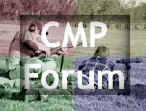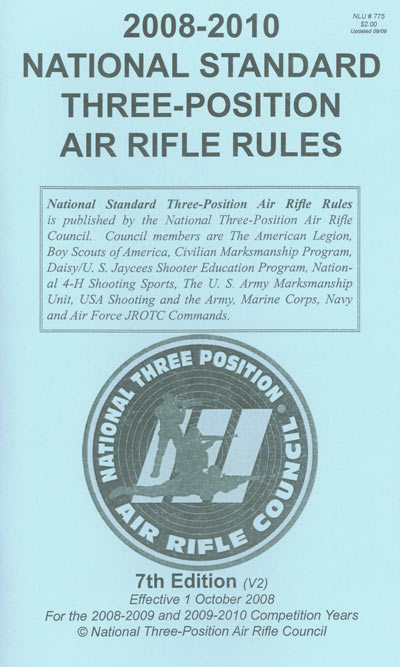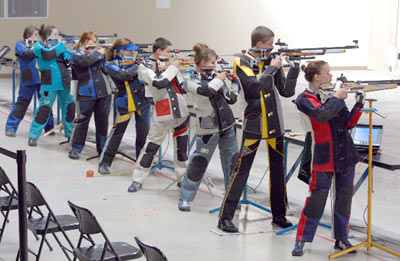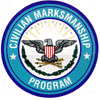

| We want your feedback! Please let us know what you think about TFS. Do you have an interesting story or article that you would like to share? If so, please let us know!
|
Upcoming CMP Events:
Tuesday Night Open Public Shooting
Camp Perry Marksmanship Center, Port Clinton, OH
Shooters, including aspiring new shooters are invited to take advantage
of a new opportunity to do practice shooting on Tuesday evenings at the
Camp Perry Marksmanship Center air gun range. The Camp Perry 80-point,
10-meter air gun range is fully equipped with electronic targets that
accommodate air rifle, air pistol or National Match Air Rifle shooting.
Instruction and equipment are available. Visit
http://www.odcmp.com/
MarksmanshipCenters.htm for additional information.
Western CMP Games and Creedmoor Cup Matches
Phoenix, AZ
The 2009 Western CMP Games and Creedmoor Cup Matches will take place at
the Ben Avery Shooting Facility North of Phoenix, Arizona on 17-25
October. The Official Program for the 6th Western CMP Games and
Creedmoor Cup Matches is posted and available at
http://www.odcmp.com/Competitions/
WesternGames.htm. The 2009 CMP Games program has been changed so
that competitors can attend the popular new shooter clinic on Saturday
morning, 17 October, and then shoot three Garand-Springfield-Vintage
Military Rifle Matches on Saturday afternoon and Monday and Tuesday
mornings. The As-Issued M1 Garand EIC Match has been moved to Sunday
morning, 18 October, so that more shooters can compete for special
4-point EIC legs in that match. This year, CMP Games competitors will
also be able to shoot in a Rimfire Sporter Match on Sunday afternoon and
a Carbine Match on Monday afternoon. Creedmoor Cup competitors can
attend a free highpower rifle clinic on Wednesday, 21 October, and then
shoot on successive days, a practice match, a NMC team match, the
80-shot Creedmoor Cup Match and finally a Service Rifle EIC Match. You
can register to compete in either or both the CMP Games Matches and the
Creedmoor Cup Matches on-line at
http://clubs.odcmp.com/
cgi-bin/matchInfo.cgi?matchID=4969.
Anniston Marksmanship Center Monthly Match
Anniston, AL
The Civilian Marksmanship Program (CMP) invites you and your club rifle
team to participate in our Air Gun Monthly Matches. These monthly
matches take place at the CMP’s brand new Competition Center in
Anniston, AL. The competitions will feature a Junior Air Rifle
3x20, NMAR 3x20, 60 Shots Air Rifle Standing, 60 Shots Air Pistol and 30
shots Novice Prone and Benchrest. Anniston (Alabama) matches are 24
October . Visit
http://www.odcmp.com/
MarksmanshipCenters.htm for more information and on-line
registration.
Camp Perry Marksmanship Center Monthly Match
Port Clinton, OH
The Civilian Marksmanship Program (CMP) invites you and your club rifle
team to participate in our Air Gun Monthly Matches. These monthly
matches take place at the CMP’s brand new Competition Center in Port
Clinton, OH. The competitions will feature a Junior Air Rifle
3x20, NMAR 3x20, 60 Shots Air Rifle Standing, 60 Shots Air Pistol and 30
shots Novice Prone and Benchrest. Camp Perry (Ohio) matches are 24
October and 21 November. Visit
http://www.odcmp.com/
MarksmanshipCenters.htm for more information and on-line
registration.
2009 Gary Anderson Invitational
Anniston, AL
You and your shooters are cordially invited to participate in the 2009
Gary Anderson Invitational, one of the major junior shooting
championships in the country. The invitational offers three-position air
rifle competition for middle and high school individuals and teams in
both precision and sporter class divisions. Both divisions will have
awards for competitors who fire the top individual and team scores.
There will also be special awards for the best new shooters and junior
varsity teams. The winning precision and sporter teams will receive
trophy plaques and have their team information engraved on the Gary
Anderson Invitational Trophy. The top three sporter and precision teams
will also receive cash awards of $500, $300 and $200 respectively.
Medals will be awarded to the top 25 open and top 15 new shooters in
both the sporter and precision classes. Every shooter and team,
regardless of the type of equipment they use or their level of
experience, will have an opportunity to compete for awards in a truly
high quality competition on one of the finest air gun shooting
facilities in the world. This Excellence-in-Competition championship is
one that every team should attend—we sincerely hope you and your team
will join us in Anniston in December for a great competition.
Visit
http://www.odcmp.com/3P/GAI.htm for more information and on-line
registration.
|
|
|
 |
Three-Position Air Rifle Rules Update
By Gary Anderson, Chairman,
National Three-Position Air Rifle Council
|
|
An updated version of the National Standard Three-Position Air Rifle Rules is now posted on the CMP website at http://www.odcmp.com/3P/Rules.pdf. The revised rules are also available from the CMP in print. The updated rules incorporate changes adopted by the National Three-Position Air Rifle Council when it held its annual meeting at Fort Benning, Georgia this past June. The rulebook (V1) that was released in September 2008 was intended to be a two-year rulebook so most of the changes in the revised rules (V2) are minor and editorial. The revisions, however, were made necessary by recent equipment and technical developments that include a newly approved Sporter Class air rifle and the commercial availability of the Orion Scoring System that uses computer-imaging technology to score paper targets.
 |
|
Copies of the 2008-2010 National Standard Three-Position Air Rifle Rules 7th Edition, V2, can now be downloaded from the CMP website at http://www.odcmp.com/3P/Rules.pdf.
|
The newest version of the rules is designated “7th Edition (V2).” Its first change appears on the cover. Air Force JROTC is now added to the list of organizations that are part of the National Three-Position Air Rifle Council. This change reflects the rapid growth of the new and fast growing Air Force JROTC air rifle marksmanship program.
The new Sporter Class air rifle, which was approved at this summer’s Council meeting, is the Crosman Challenger 2009. The CH2009 is designed to use a fixed cylinder that can be charged with either compressed air or CO2 gas. It is equipped with a pressure gauge, a Lothar Walther barrel, adjustable cheek-piece and adjustable butt-plate. The Crosman CH2009 is available to “qualified instructional groups” at $410.00 (with sights, $345.00 without sights) through Crosman’s EASY program (http://www.crosman.com/airguns/easy).
 |
|
The Crosman CH2009 is the newest air rifle approved for use in National Three-Position Air Rifle Sporter Class competition.
|
There are currently three approved Sporter Class air rifles that have adjustable butt-plates and cheek-pieces. When using these rifles in Sporter Class competition, Rule 4.2.4, which controls how these adjustments may be used, must be followed. Shooters who use these air rifles may adjust the butt-stock length and cheek-piece height in practice before a competition. Once they start a competition, the stock length and cheek-piece must remain unchanged for the firing of all three positions. Butt-plates that may be moved up and down must, according to this rule, be fixed in the neutral position and also may not be adjusted up or down during the competition. The purpose of these restrictions is to equalize conditions for all Sporter Class competitors regardless of whether their rifles have these adjustments or have standard stocks with no adjustments.
If an air rifle like the CH2009 that has an adjustable butt-plate and cheek-piece is used in an open or precision class competition, then, of course, those adjustments may be used and changed when moving from one position to the next.
In approving the Crosman sporter, the Council continued its practice of only approving specific Sporter Class air rifles by manufacturer and model. The Council has also adopted a price ceiling of $525.00 with sights. The fundamental reason for these restrictions is so the Council and not the manufacturers can control what a Sporter Class air rifle is. Without these controls, manufacturers would be free to introduce features that could escalate the cost and accessibility of Sporter Class air rifle shooting more rapidly than is desired.
The controversy that erupted over swimsuit technology at this past summer’s Swimming World Championship is a compelling example of why sports governing bodies must maintain control of their equipment rules. Swimming’s problem developed because swimsuit manufacturers had developed special swimsuits that increased the buoyancy of swimmers in the water and made previous world records meaningless. This was called “technological doping” by many swimming experts. A corollary problem was that these suits cost multiple hundreds of dollars to make swimming too expensive for many teams and individuals at the club and grassroots levels to compete.
The Council approved two special statements regarding its requirements that all Sporter Class air rifles must be approved by manufacturer and model and that Sporter air rifle prices cannot exceed $525.00.
-
Rule 4.2.1 approval of an air rifle as a legal Sporter Class air rifle confirms that a specific air rifle fulfills National Standard Rule 4.0 requirements for velocity, function, cost, weight, trigger weight capability and general configuration. Council approval does not, however, convey any representation or guarantees regarding the accuracy, performance or durability of that air rifle.
-
The price ceiling specified in Rule 4.2.1 may be a price that is available to junior shooting programs through a manufacturer’s special marketing program. Special marketing prices for junior shooting programs are available for Air Force Air Guns, Crosman and Daisy Sporter Class air rifles. For detailed information regarding special marketing programs, contact 3PAR@odcmp.com or call 419-635-2141, ext. 1102.
 |
|
Final round competitors in the 2009 National Junior Olympic Three-Position Precision Class Championship. Starting with this match, the precision and sporter class competitors with the highest 10-shot final round scores will be recognized as National Record holders.
|
The first statement is a reminder to air rifle purchasers that Council approval of a particular air rifle as a legal Sporter Class air rifle is not a guarantee regarding how accurate or reliable that air rifle is. The Council determines whether the rifle is configured as a legal Sporter Class air rifle. Buyers are responsible for determining whether the accuracy or performance of a particular model is suitable for them. The second statement addresses the fact that while manufacturer’s suggested retail prices for an approved air rifle may exceed the Council’s $525.00 ceiling, that does not matter as long as that particular air rifle is available for purchase by organized youth programs for a price that is less than the ceiling price. Both Daisy and Crosman have special marketing programs that meet this requirement and Air Force Air Guns has agreed to implement such a program when its Edge comes on the market. For more information on these programs contact the manufacturers or Vicki Donoho, 419-635-2141 ext. 1102 or vdonoho@odcmp.com.
Two new rule changes deal with National Records. Starting with this summer’s three-position air rifle championships, the best sporter and precision class final round scores will be recognized as National Records. 10-shot final round scores will, however, only be recognized if electronic targets or electronic scoring (Orion) are used to score all shots in 10th ring values. Results bulletins from National Three-Position Air Rifle Council Championships this past July and August currently are being screened to determine the initial final round record holders.
A second rule change regarding records stems from the 2008 Council decision to follow the ISSF (International Shooting Sports Federation) lead and score inner tens and use inner ten totals as the first step in tiebreaking. Until now, all national records with the same numerical score were recorded as national record co-holders. This is already resulting in several long lists of record co-holders. Since inner ten totals are a valid means of determining which of two numerically equal scores is the best, it is logical that inner tens should be used to make the same determination in recognizing national records.
On the night of the National Trophy Matches closing awards ceremony, Clark was awarded the Bushmaster Cup by Bushmaster and Remington Arms; the junior award went to friend Amanda Elsenboss who had the second highest junior aggregate. Clark was also awarded the “Bill Deneke“ highpower team medal and was welcomed to the 2009 National Trophy Service Rifle Junior Team.
Starting with record scores fired after 1 July 2009, inner tens must be scored and recorded for all national records. Any possible records that are fired after that date that are numerically equal to an existing record must equal or exceed the inner ten count for that record in order to be recognized.
The increased use of electronic targets for major three-position air rifle competitions and the fast growing use of the Orion electronic scoring system for paper targets has made it necessary to update the rules for scoring and score protests. The revised rules explicitly recognize three scoring methods, 1) manual scoring of paper targets with scoring gauges and human judgment, 2) electronic scoring targets and 3) electronic scoring of paper targets.
As a first step, the rules had to recognize that electronic scoring with computer technology and manual scoring are two completely different methods of scoring. Manual scoring compares the outside edge of a scoring gauge with the outside edge of a scoring ring to determine whether a close shot receives a higher or lower value. Electronic targets and electronic scoring, on the other hand, measure the radial distance from the exact center of a shot hole to the exact center of the target. Since all three scoring methods are subject to certain tolerances that differ from one method to the next, it is neither fair nor accurate to use one scoring method to check the accuracy of another.
Rules for electronic targets also needed to be updated to coordinate them with ISSF rules, while score challenge rules for electronic scoring (Orion) had to be developed to reflect the understanding that electronic and manual scoring cannot be used to check results from another scoring method.
Rule 8.0, SCORING PROCEDURES, was extensively rewritten to reflect these standards and to move Score Protest procedures (Rule 9.1 in the V1 edition) to Rule 8.0 where there are separate score protest or challenge procedures for each of the three methods of scoring. There is a general Score Protest section, Rule 8.2, that states conditions applying to all score protests regardless of the method of scoring. The specific rule for challenges of manual scores on paper targets, Rule 8.3.5, remains unchanged. There, shot values that were gauged once cannot be regauged; competitors may only challenge shots that were previously ungauged.
Rule 8.4.2, Protests of Electronic Target Scores, incorporates 2009-2012 ISSF rules for protesting shot values scored by electronic targets. These rules cover what to do when a target fails to register a shot, when the target’s paper band fails to advance or when a competitor feels a shot was scored inaccurately. Competition officials who work on ranges equipped with electronic targets are encouraged not only to study the new Rule 8.4.2 carefully, but also to study and understand the following ISSF Rules:
6.13 FAILURE OF ELECTRONIC SCORING TARGET SYSTEMS
6.15.4.2 Scoring Protests – Electronic scoring targets
Rule 8.5, VISUAL IMAGE SCORING SYSTEMS, was added to give specific directions for the use of the new Orion Scoring System in three-position air rifle competitions. The Orion system uses computer vision techniques to score targets by scanning targets and shot holes to digitize their images and calculate the radial distances of each shot hole from the target center. The Orion system was approved for use in National Council sanctioned competitions starting in 2008. The Orion Scoring System has been used for three years to score air rifle targets from the American Legion, JROTC and U. S. Army junior three-position air rifle postals. Orion recently completed beta testing and is now available in a commercial version from Shooters Technology, LLC. The Orion website is at http://www.orionscoringsystem.com/home or send email inquiries to support@shooterstech.net.
The revised rules provide a new shot value protest procedure that follows the principle that one method of scoring cannot be used to check the accuracy of another. New Rule 8.5.5 provides that an individual shot value scored by Orion may be protested and that if it is, the entire target will be rescored using the original scan and a “higher resolution, but slower processing mode.” There is very little difference in the scoring confidence level between the two processing modes, but the time difference is great. This is why the recheck mode is not used for all scoring passes.
It is also possible that as more experience is gained with the Orion system, that rescoring challenged shots may be eliminated entirely, just as it is already precluded by the rules for manual scoring (no gauged shot may be regauged) or electronic targets where there is no means for match officials to recheck the actual accuracy of any one shot.
The 2008-2010 National Standard Three-Position Air Rifle Rules, 7th Edition V2 version, is now posted on the CMP website at http://www.odcmp.com/3P/Rules.pdf. You can download the rules from there. You can also order printed copies of the rulebook from the CMP for $2.00 each.
Anyone with questions about three-position air rifle rules is reminded that the National Council maintains a Rules Hotline. To get your questions answers or to seek a rules interpretation, Vicki Donoho, 419-635-2141, ext. 1102, or vdonoho@odcmp.com or Katie Harrington, 419-635-2141, ext. 1131 or kharrington@odcmp.com.
|
|
|


